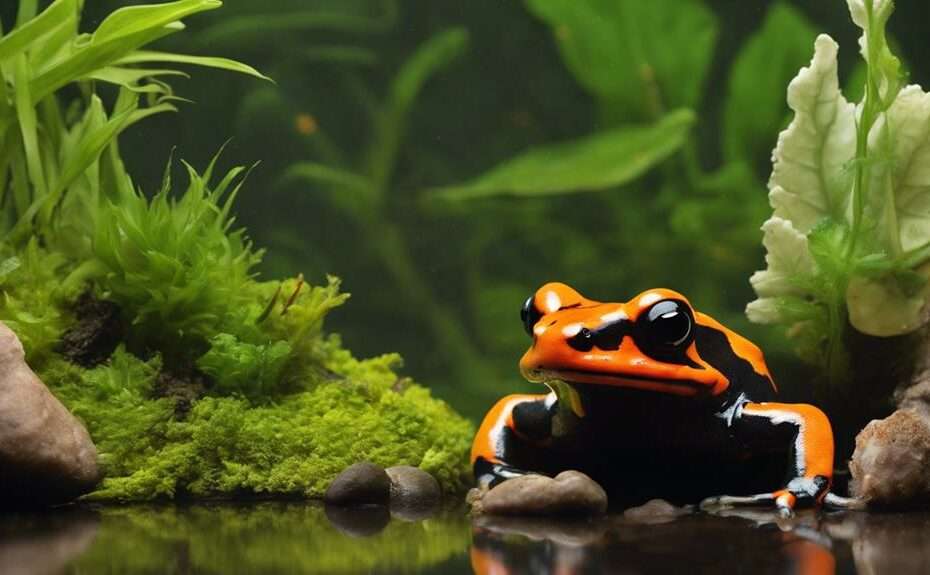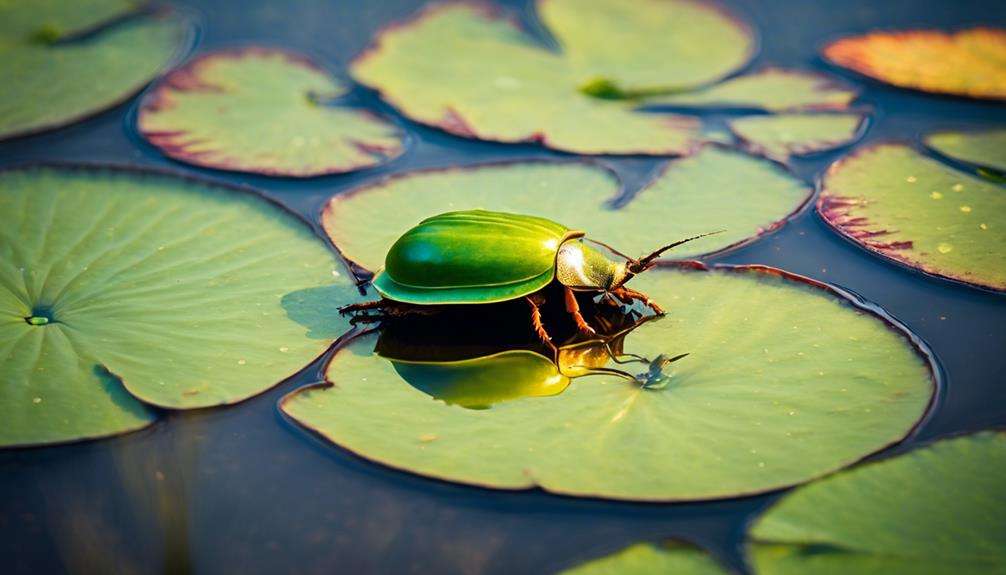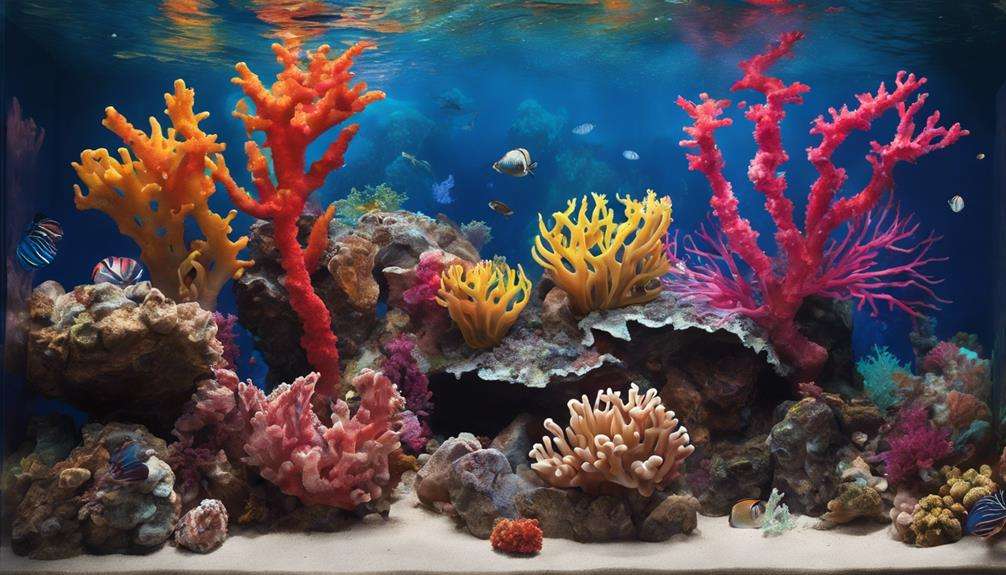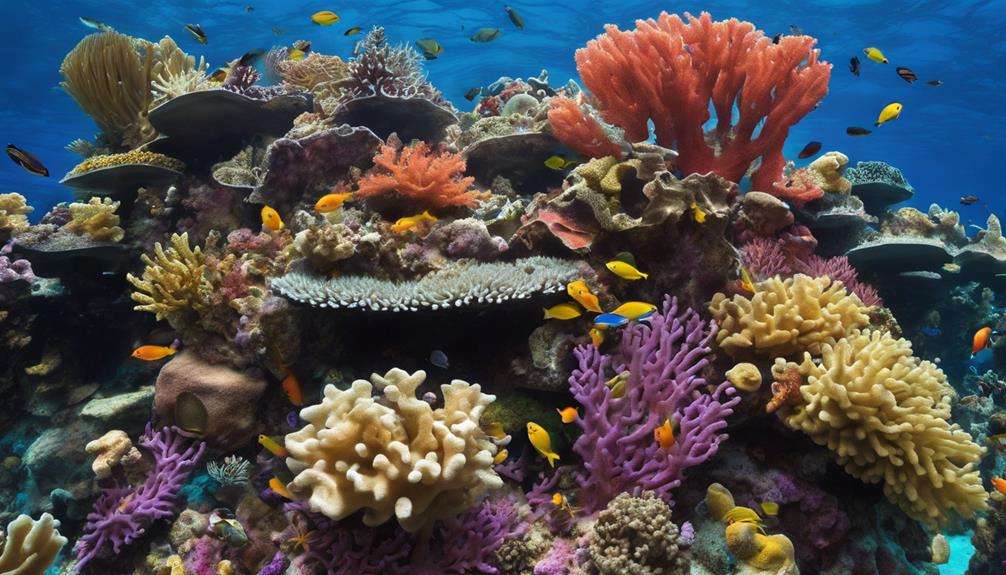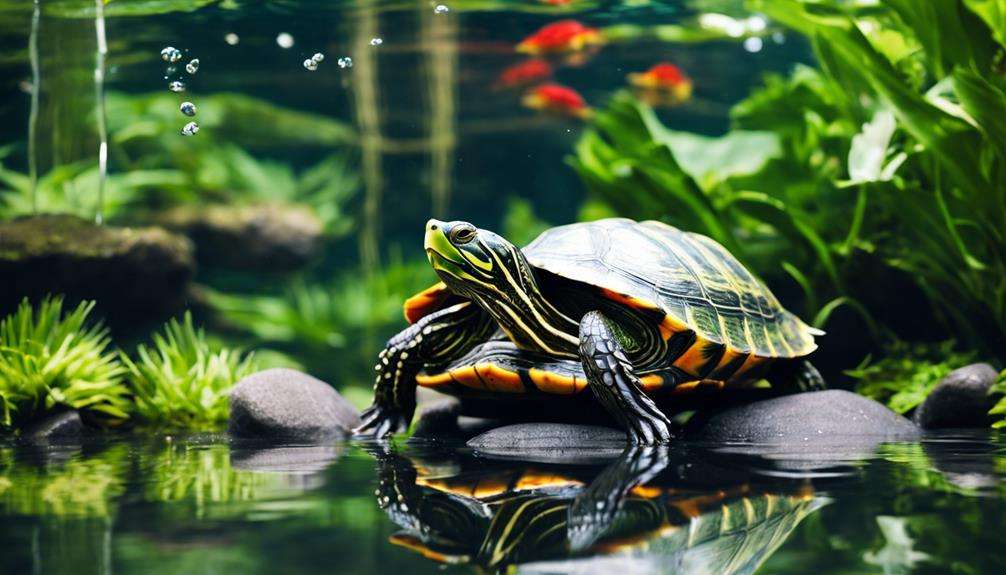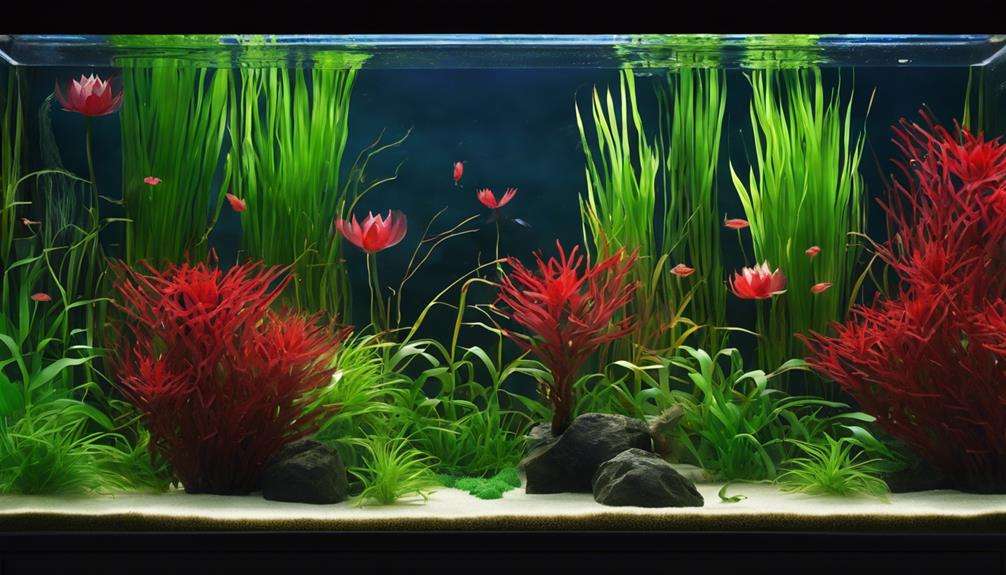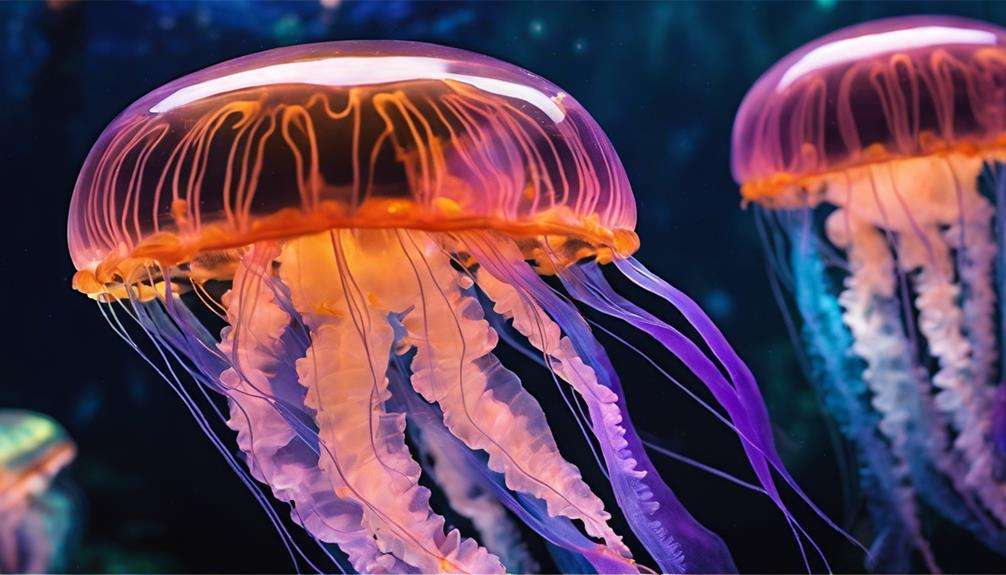If you're concerned that small tank setups may limit your options for amphibians, fear not. There are several species perfectly suited for compact enclosures that offer an exciting array of colors and behaviors.
From tiny dart frogs that bring a pop of color to your space to miniature salamanders that add a touch of uniqueness, the world of small tank amphibians is diverse and fascinating. Explore these intriguing creatures further to discover which one might be the perfect fit for your miniature aquatic ecosystem.
Key Takeaways
- Dart Frogs and Miniature Salamanders are ideal for small tanks due to their compact size and vibrant colors.
- Nano Tree Frogs thrive in small tanks with high humidity levels and live prey like small crickets.
- Feeding and maintenance are crucial for keeping small amphibians healthy and active in confined tank setups.
- Diminutive Glass Frogs and Mudskippers bring exotic beauty and diverse behaviors to compact tank ecosystems.
Tiny Dart Frogs for Small Tanks
Tiny dart frogs make an excellent choice for small tank setups due to their compact size and vibrant colors. These frog species, known for their thumbnail-sized dimensions, are perfectly suited for intimate tank environments. Their petite stature allows for easy accommodation in limited spaces, making them an ideal option for hobbyists with small tanks. The stunning hues exhibited by dart frogs add a visual appeal to the enclosure, creating a mesmerizing display for observers.
In addition to their visual charm, dart frogs are diurnal creatures, meaning they're active during the day. This behavior provides enthusiasts with the opportunity to observe their fascinating movements and interactions throughout daylight hours. To thrive in captivity, dart frogs require high humidity levels, replicating their natural habitat conditions. Their preference for living in small groups further enhances their suitability for small tank setups, as it allows for social dynamics within the limited space provided. Additionally, it's notable that dart frogs lose their toxicity in captivity, as their toxic properties are acquired from their wild diet.
Miniature Salamanders Ideal for Tanks
Miniature salamanders, such as the pygmy salamander (Desmognathus wrighti), offer an excellent choice for small tank setups due to their diminutive size and specific care requirements. These petite amphibians typically reach lengths of 2-3 inches, making them well-suited for compact enclosures.
Pygmy salamanders are mostly terrestrial creatures, necessitating a moist substrate to uphold adequate humidity levels within their tank environment. As insectivores, they sustain themselves on a diet of small invertebrates like springtails, fruit flies, and pinhead crickets.
To guarantee the well-being of miniature salamanders in small tanks, it's important to provide hiding spots, live plants for cover, and a shallow water dish for soaking. By catering to their modest space requirements and specialized needs, miniature salamanders can flourish in confined tank setups, offering enthusiasts a fascinating glimpse into the world of these intriguing amphibians.
Nano Tree Frogs for Compact Tanks
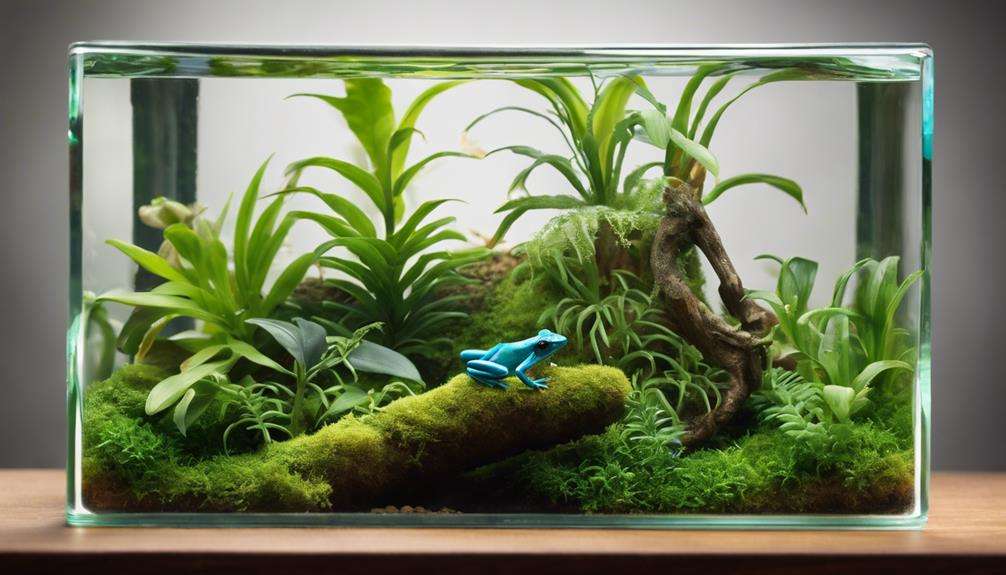
Nano tree frogs, being small creatures, are ideal for compact tank setups due to their size, typically reaching around 1 inch in length.
These frogs require live prey like small crickets, fruit flies, and pinhead crickets for their diet, making their feeding requirements specific and essential for their health.
To guarantee the well-being of nano tree frogs in compact tanks, maintaining high humidity levels of around 60-80% and providing ample hiding spots and climbing areas with live or artificial plants are critical aspects to contemplate.
Ideal Tank Size
Ideal tank size for accommodating nano tree frogs in compact setups typically ranges from 5 to 10 gallons, providing ample space for their arboreal nature and climbing behaviors.
These miniature tree frogs, such as dart frogs or glass frogs, are well-suited for small tanks due to their modest size and minimal space requirements.
Nano tree frogs thrive in vertically oriented tanks with plenty of climbing opportunities and live plants for cover. Ensuring a habitat that mimics their natural arboreal environment is essential for their well-being in small tanks.
Feeding Requirements
In compact tank setups, the feeding requirements for nano tree frogs focus on a diet primarily consisting of small live insects like fruit flies, pinhead crickets, and springtails. Due to their high metabolisms, nano tree frogs need frequent feedings of appropriately sized prey to stay healthy.
To guarantee the prey is well-fed with nutritious foods such as leafy greens or commercial insect diets to enhance the nutritional value for these tiny amphibians. Dusting the prey with calcium and vitamin supplements guarantees that nano tree frogs receive essential nutrients for their growth and development.
Offering a varied diet of different insect species can help prevent nutritional deficiencies and keep nano tree frogs active and thriving in small tank setups.
Maintenance Tips
For effective maintenance of compact tanks housing nano tree frogs, prioritize regular cleaning to eliminate waste and uphold prime water quality essential for the amphibians' well-being. Cleaning the tank regularly will help prevent the build-up of toxins and guarantee a clean and healthy habitat for your nano tree frogs.
It's vital to monitor the temperature and humidity levels within the tank to guarantee they're ideal for tree frogs. Additionally, offering a varied diet of small insects like fruit flies or pinhead crickets will meet the nutritional needs of your nano tree frogs.
Creating a natural environment with live plants and hides will provide enrichment for the tree frogs while mimicking their natural habitat. Conducting routine water changes is also essential to maintain a pristine environment for your small tank tree frogs.
Lilliputian Newts for Small Enclosures
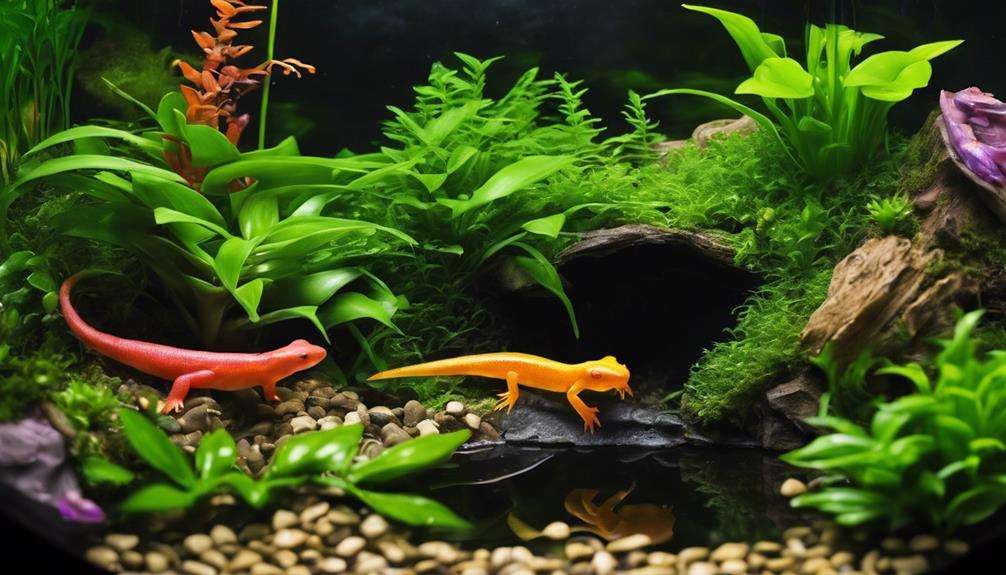
Lilliputian newts, also known as pygmy newts, are fascinating tiny amphibians that thrive in compact tank setups. These small newts, usually reaching around 1.5 inches in size, are perfectly suited for small enclosures due to their diminutive stature. When creating a habitat for lilliputian newts, make sure the tank is aquatic, with clean water and hiding spots for these small creatures to feel secure. Observing these tiny newts in a small tank environment can be enthralling, as they exhibit unique behaviors and movements that are accentuated by the limited space.
To maintain the health of lilliputian newts in small enclosures, it's important to provide them with a varied diet and make sure the water parameters are suitable for their well-being. These low-maintenance amphibians can thrive in a well-designed small tank, adding a touch of wonder to your living space with their small size and intriguing behaviors.
Pocket-Sized Fire Belly Toads
Shifting from the tiny lilliputian newts, the next enchanting subject in small tank setups is the pocket-sized fire belly toads, also known as bombina orientalis. These small amphibians, originating from Korea and China, sport striking orange or red bellies adorned with black markings, serving as a bold warning sign to potential predators due to their toxic skin secretions.
Fire belly toads are hardy creatures, making them ideal for small tank setups. They thrive when provided with a semi-aquatic environment that includes both water and land areas for swimming and basking. In captivity, these insectivores enjoy a diet of small live insects like crickets, worms, and flies.
Their easy care requirements and alluring appearance make fire belly toads a popular choice for amphibian enthusiasts looking to create a vibrant and dynamic display in their small tank setups.
Diminutive Glass Frogs for Petite Tanks
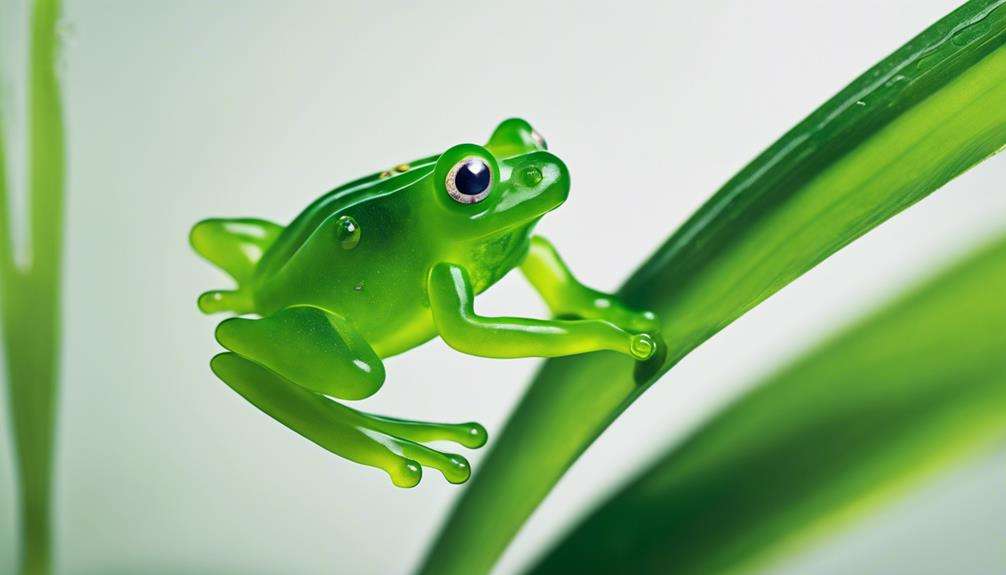
When considering setting up a petite tank, one fascinating option to explore is the diminutive Glass Frogs, known for their unique characteristics and suitability for small environments.
Glass frogs, such as the diminutive Centrolene prosoblepon, are ideal for small tanks due to their petite size, typically around 0.8-1.5 inches in length. These frogs are distinguished by their translucent undersides, allowing visibility of their internal organs, which adds an intriguing element to tiny setups.
To thrive, diminutive glass frogs require a humid environment with temperatures around 72-80°F and ample foliage for hiding and climbing. Their diet primarily consists of small insects like fruit flies and pinhead crickets, making them relatively easy to feed in small tank environments.
With their unique appearance and low maintenance requirements, diminutive glass frogs bring a touch of exotic beauty to compact amphibian setups, making them an excellent choice for those looking to create a captivating miniature ecosystem.
Wee Mudskippers for Small Aquaria
Wee mudskippers, small amphibious fish, require a tank setup that includes both land and water areas to thrive. Ensuring a suitable tank size to accommodate their natural behaviors is essential for their well-being.
Providing a diverse diet of live and frozen foods is vital for keeping these active and curious creatures healthy and happy in your aquarium.
Mudskipper Tank Size
A small tank setup of around 10 gallons is ideal for housing wee mudskippers like Periophthalmus novemradiatus, allowing them to thrive in a brackish water environment that meets their unique needs.
Mudskippers require a tank size that provides both water and land areas. It's important to include a land area in the tank setup for mudskippers to rest and exhibit their characteristic behavior of moving on land using their pectoral fins.
The tank should be designed to accommodate their need for a blend of salt and freshwater, creating a brackish environment that mimics their natural habitat. By ensuring the tank size is suitable and includes a land area, you can provide a comfortable and stimulating environment for wee mudskippers to flourish.
Mudskipper Feeding Tips
To guarantee the best health and nutrition of wee mudskippers in small aquaria, it's important to carefully consider their feeding habits and dietary requirements.
Wee mudskippers thrive on a diet of small live foods such as bloodworms, brine shrimp, and small insects. These creatures benefit greatly from a varied diet to make sure they receive all the necessary nutrients for growth and vitality.
Providing a diverse range of live foods will help mimic their natural feeding behavior and support their overall well-being. Remember, a balanced and nutritious diet is key to keeping wee mudskippers healthy and active in your small tank setup.
Mudskipper Behavior Traits
When observing the behavior traits of mudskippers in small aquaria, it becomes evident that these unique amphibians exhibit remarkable adaptations for both aquatic and terrestrial environments.
Wee mudskippers, suitable for small tanks, showcase intriguing behaviors such as climbing, basking, and 'walking' on land using their pectoral fins.
These tiny mudskippers thrive in setups that offer a mix of sandy substrate, rocks, driftwood, and live plants to create a dynamic environment. To mimic their natural habitat effectively, a well-ventilated tank with both a water area and a dry land area is essential for their well-being.
Providing such an environment allows wee mudskippers to explore, exhibit their natural behaviors, and thrive in small tank setups.
Minute Clawed Frogs for Tiny Tanks
In small tank setups, dwarf clawed frogs are the best choice due to their minimal space requirements of just a 2-gallon enclosure. These frogs, scientifically known as Hymenochirus, are specifically well-suited for small tanks due to their petite size and simple care needs. They thrive in clean water conditions, so regular water changes are essential to maintain their health. Feeding them is uncomplicated as they readily consume pellet fish food, making them an easy choice for beginners looking to care for amphibians in a confined space.
Their diminutive stature not only makes them a great fit for compact living spaces but also contributes to their popularity in the world of small tank setups. Despite their small size, dwarf clawed frogs are hardy creatures that can adapt well to captive environments, provided that their habitat is well-maintained. Their low maintenance requirements further solidify their position as a favored choice for those seeking amphibians for tiny tanks.
Teeny Tiny Surinam Toads
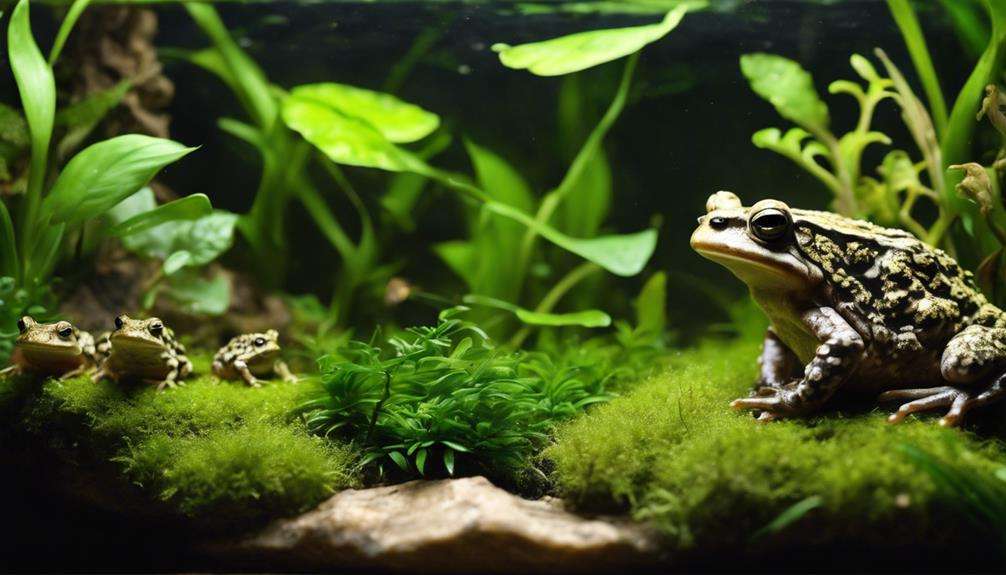
Surinam toads demand meticulous care due to their unique features, like the female's back-carrying of eggs. Tank size is vital for these amphibians, with shallow water and hiding spots as essential components.
Feeding these carnivorous toads a diet of small fish, insects, and crustaceans offers a glimpse into their intriguing predatory nature.
Surinam Toad Care
The care of these unique, tiny amphibians, known as Teeny Tiny Surinam Toads, demands specialized attention to mimic their natural aquatic habitat. Surinam toads, being fully aquatic pet amphibians, require a tank with a soft substrate to prevent injuries as they spend most of their time at the bottom, blending in with their environment.
Maintaining clean water with efficient filtration is important for their well-being. These aquatic animals have a distinctive reproductive strategy where the female carries fertilized eggs on her back until they hatch into tadpoles.
To guarantee their health, offer a varied diet consisting of small live foods. Providing attentive care and creating suitable tank conditions are essential for the Surinam toads to thrive in captivity.
Tank Size Requirements
What tank size does your Teeny Tiny Surinam Toad require to accommodate their small size and limited movement?
Teeny Tiny Surinam Toads need a minimum tank size of 5 gallons to thrive. Due to their expert burrowing nature, it's important to provide ample substrate depth for them to exhibit this behavior.
These toads spend a significant amount of time submerged; hence, including a shallow water area in the tank setup is essential. To mimic their natural habitat and offer enrichment, incorporate hiding spots and plants.
Remember to maintain clean water conditions and monitor temperature and humidity levels diligently to guarantee the well-being of your Teeny Tiny Surinam Toads in their tank environment.
Feeding Surinam Toads
How can you guarantee the best nutrition intake for your Teeny Tiny Surinam Toads to support their growth and development effectively?
Feeding these small amphibians involves providing a diet rich in live food such as daphnia, brine shrimp, and bloodworms. Teeny tiny Surinam toads have specialized dietary requirements, necessitating nutrient-packed meals to make sure the best development. It's important to offer a variety of live food to meet their nutritional needs adequately.
Small Tank Suitable Dwarf Frogs
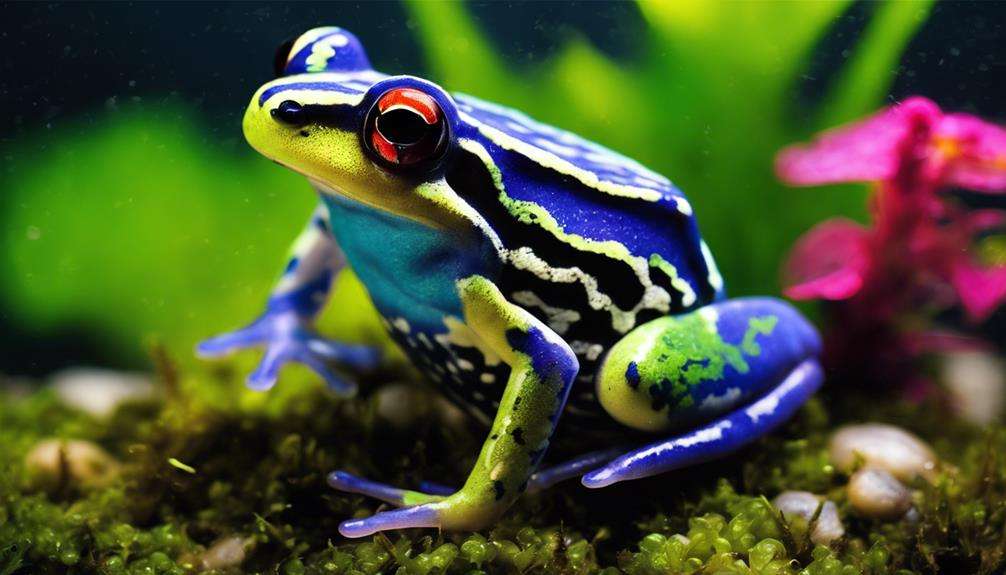
When setting up a small tank for dwarf frogs, make sure proper water cleanliness and pellet fish food for their thriving environment.
Dwarf clawed frogs, well-suited for compact living spaces, can comfortably inhabit a 2-gallon tank. These frogs, known for their ease of care, are an excellent choice for beginners or those with limited space.
Unlike some amphibians, dwarf clawed frogs don't necessitate heaters or special lighting, simplifying the setup process for small tanks.
To create an ideal habitat, consider incorporating live plants and water dishes to mimic their natural environment.
Providing a suitable environment with clean water and proper nutrition allows dwarf clawed frogs to live happily in small tank setups. With their small size and low maintenance requirements, these frogs are a practical and enjoyable addition to small aquatic habitats.
Make sure you monitor water quality regularly and feed them a balanced diet of pellet fish food to promote their well-being in your miniature aquatic ecosystem.
Frequently Asked Questions
What Frog Needs the Smallest Tank?
For the smallest tank, consider the tiny terrariums suitable for compact companions like the dwarf clawed frog. These frogs thrive in small spaces with clean water and fish food, making them a perfect fit for minimalistic setups.
What Is the Best Beginner Amphibian?
For the best beginner amphibian, consider the dwarf clawed frog. It thrives in a 2-gallon tank, needing clean water and fish pellets. No heating or lighting required, simplifying setup. Enjoy observing their unique behaviors in a small tank.
What Frogs Can Live in a 5 Gallon Tank?
In a 5-gallon tank, consider African Dwarf Frogs, Fire Belly Toads, or Clown Tree Frogs. Guarantee proper habitats with swimming and resting areas. Monitor humidity and ventilation for their well-being. Upgrade tank size as needed for species like White's Tree Frogs.
What Amphibians Can Live With Fish?
When considering amphibians and invertebrates living with fish, confirm compatibility with shrimp. Research your choices thoroughly to foster a harmonious tank. Match species that won't compete for resources or harm each other, promoting a balanced aquatic environment.
Conclusion
Thus, when selecting amphibians for small tank setups, consider the tiny dart frogs, miniature salamanders, nano tree frogs, lilliputian newts, pocket-sized fire belly toads, wee mudskippers, minute clawed frogs, teeny tiny Surinam toads, and small tank suitable dwarf frogs.
These compact species offer a diverse range of options for small tank enthusiasts.
Remember, just like a frog in a small pond, these amphibians can bring a big splash of joy to your miniature aquatic world.
